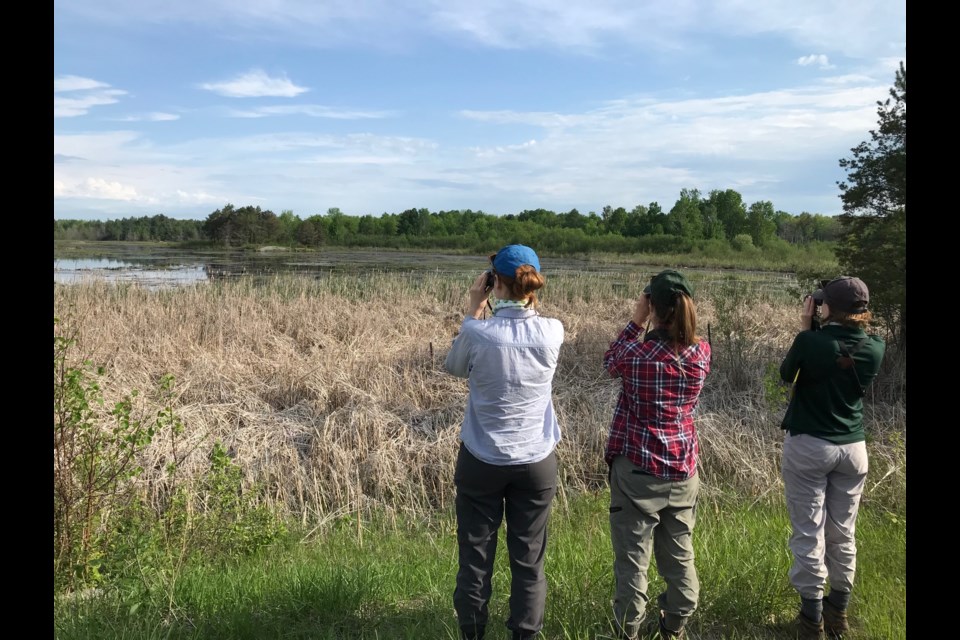More than $22,000 was raised this weekend during the 14th annual Carden Challenge, a 24-hour marathon event in which 10 teams (44 participants) counted as many species as possible on the globally rare tract of land east of Orillia.
“Basically, this event has provided 14 years of citizen science for birds and, more recently, we started to expand that information base,” explained Mark Bisset, the executive director of the Couchiching Conservancy, which organizes the annual challenge.
Thanks to a new biodiversity category, reptiles, amphibians, insects, dragonflies and mammals are also scrutinized during the annual blitz.
“This year, we had 44 people, most of whom are really good naturalists, out on the alvar looking at it very intently, so it gives us a really good snapshot from year to year,” said Bisset.
While data has not yet been tabulated, participants did see some firsts this year – including a Nelson’s warbler, which had never before been spotted in Carden.
“Carden is one of the few places in Ontario where grasslands birds are still quite abundant,” said Bisset, who noted, for example, that the eastern meadowlark “has all but disappeared” in southern Ontario. “But we still see them in Carden because they have a stable, large space.”
Bisset described the alvar as an “island for species,” noting the different habitats – wooded areas, wetlands, forested swamps, river habitat – provide refuge for numerous species.
The Carden Alvar is comprised of almost 30,000 acres. There is about 13,000 acres at the centre of the property that is particularly special. In fact, this type of land is found in only a handful of places around the world.
Bisset noted, for example, the Carden Alvar is home to the endangered eastern loggerhead shrike. “In 2017, there were 26 nesting pairs in the wild and 12 of those were in Carden, so that gives you a sense of how important Carden is,” he said, noting the conservancy works with Wildlife Preservation Canada to try to restore the “fragile” population.
And that’s why events like the Carden Challenge are so important, he said. The money raised is vital to help preserve and protect the unique land which supports 450 plant species, 238 different bird species and 142 butterfly and dragonfly species.
“Over the last 10 or 11 years, we’ve been able to attract $1.5- to $2-million in private stewardship money for ranchers to help build fences that keep cattle out of wetlands,” said Bisset. “We work with ranchers to keep the cattle grazing, which keeps the grasslands open, which keeps the birds coming back. That’s an example of the work we’re doing out there. Money raised at events like the Carden Challenge helps support that work.”
It’s important work, agreed Kristyn Ferguson of the Nature Conservancy of Canada (NCC), who had a team in the Carden Challenge.
“By surveying the same thing for 14 years in this amazing globally rare habitat,” trends can be identified, she said. “Perhaps you notice a new dragonfly or a new turtle shows up. Or, maybe, a sensitive species is not there. Maybe it’s sensitive to habitat changes like pollution or nearby development. (It’s) an early warning system to look around and sort of address those threats.”
During their 24 hours in the field, Ferguson’s team observed a red-shouldered hawk flying above Lake Dalrymple with a short-tailed weasel in its mouth. They also saw a dunlin.
“This is a bird that spends its summer in the Arctic,” she explained. “That bird likes the barren … landscape of the Arctic and it looked down on Carden on its way up there and said: ‘That’s perfect for me. I’m going to stop here for a few days.’ That says something really nice about the condition of the alvar and all the conversation work that we’ve been doing in partnership with conversancy partners and local communities.”
It also underlines the importance of protecting the resource, she said.
“This is a globally rare alvar, so we have a responsibility to take care of it,” she said, noting it’s one of 16 ‘hotspots’ the NCC identified in Ontario that is vital to protect.
“Carden is one of the most important places the NCC is working and … we are trying to do everything we can to keep it great and to make it better for the future,” said Ferguson.
That was a sentiment echoed by Bisset, who noted birders flock to the region.
“People come from all over the world to Carden,” said Bisset, who noted people from Europe, Asia and throughout North America have signed their guest book. “Carden is probably the second most visited bird site in Ontario and yet many people in this area don’t realize how unique it is. You can’t care about something if you don’t know about it, so we are trying to ensure people know about it.”
